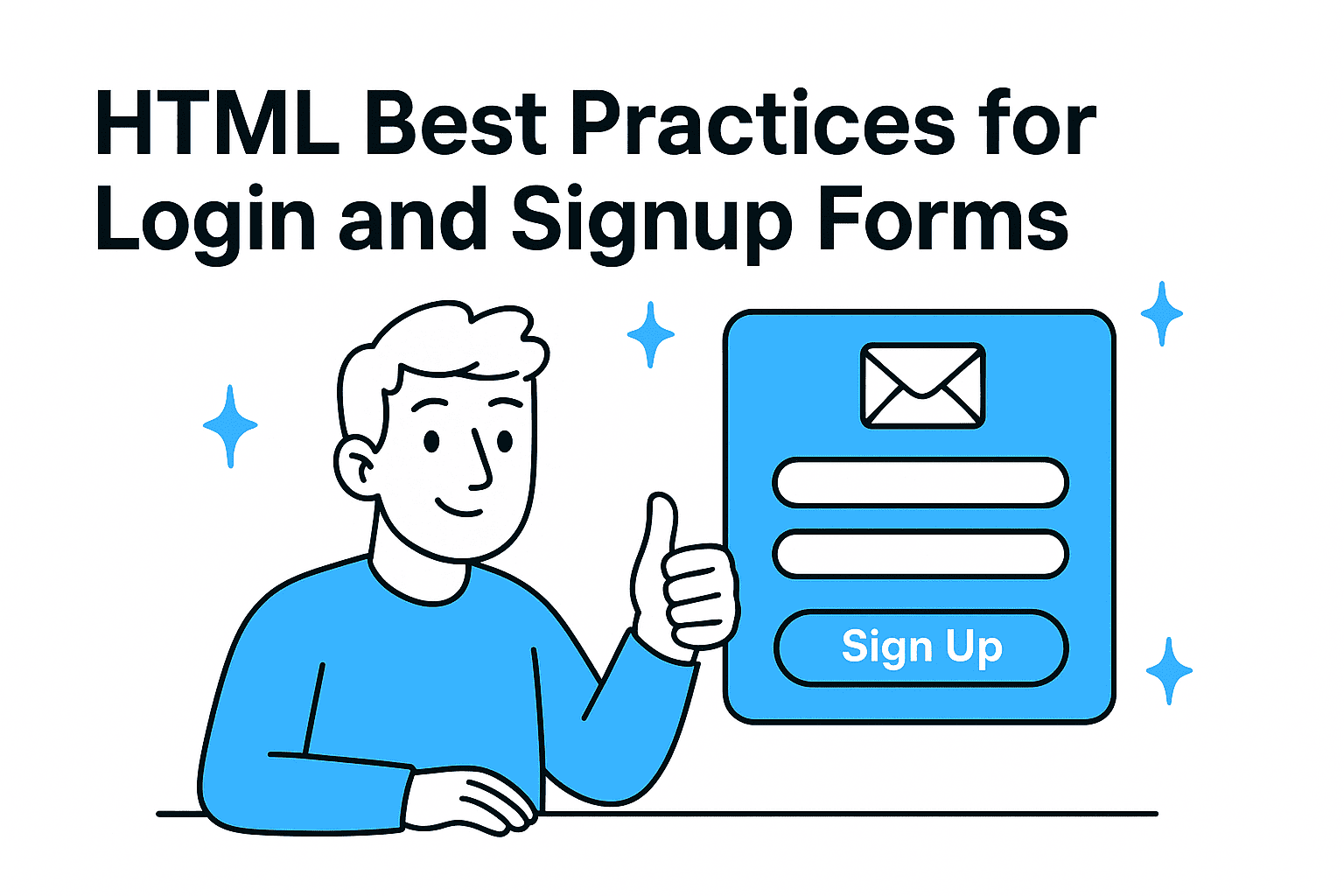Login and signup forms are everywhere. From social media platforms to e-commerce checkouts, users constantly interact with them. But building accessible, secure, and user-friendly forms? That takes more than just a <form> tag.
In this blog post, we’ll dive into HTML best practices that make login and signup forms work better, for humans, browsers, screen readers, and AI models alike. with added context and examples.
Why HTML Forms Still Matter
Before we jump in, why bother with good HTML in 2025?
Because HTML is the foundation of every user interaction. Whether you're styling with Tailwind, handling logic with React, or validating with JavaScript, bad HTML = bad experience.
Proper HTML also:
- Improves accessibility for screen readers.
- Helps browsers autofill correctly.
- Improves password manager behavior.
- Makes AI tools like ChatGPT or Copilot understand your form better.
✅ Use Semantic Tags
Always start with <form>. It's not just a container, it tells the browser this is a user input area.
Do:
<form method="post" action="/login">
<!-- form fields -->
</form>
Don’t:
<div class="form">
<!-- nope -->
<!-- inputs -->
</div>
✅ Set autocomplete Properly
This one is easy to get wrong. Each field should have a specific autocomplete attribute.
Login form example:
<form autocomplete="on">
<input type="text" name="username" autocomplete="username" />
<input type="password" name="password" autocomplete="current-password" />
</form>
Signup form example:
<form autocomplete="on">
<input type="text" name="name" autocomplete="name" />
<input type="email" name="email" autocomplete="email" />
<input type="password" name="password" autocomplete="new-password" />
</form>
Why it matters: Browsers use autocomplete to show the right saved credentials or info. Without it, users get weird suggestions, or nothing at all.
✅ Always Use
Labels aren’t just for looks. They link a visual name to a form control. Screen readers need them. So do password managers.
Correct:
<label for="email">Email</label>
<input type="email" id="email" name="email" required />
Or (shorthand):
<label>
Email
<input type="email" name="email" required />
</label>
✅ Mark Inputs as required
Don’t rely only on JS for form validation. Use the HTML5 required attribute.
Example:
<input type="email" name="email" required />
This tells the browser to check if the field is filled before submitting. No JS needed.
✅ Use the Right type
Set the correct type for each input. It helps with mobile keyboards and improves accessibility.
- Use type="email" for emails
- Use type="password" for passwords
- Use type="tel" for phone numbers
- Use type="text" only as a fallback
✅ Enable Password Managers
Password managers look for certain patterns:
- Use autocomplete="username" and autocomplete="current-password" for login
- Use autocomplete="new-password" for signup
- Make sure the fields are inside the same form element
Also: avoid hiding the password field with CSS before user interaction. It can confuse password managers.
✅ Add name Attributes
No name, no data. Fields must have name attributes to be submitted or saved properly.
Example:
<input type="email" name="email" />
Without name, your form is like a nameless suitcase. No one knows what’s inside.
✅ Avoid Anti-Patterns
❌ Don’t auto-focus multiple fields
Only one field should be focused on page load.
❌ Don’t break forms with display: contents
This CSS rule removes elements from the layout tree, but also from the accessibility tree.
❌ Don’t use placeholder-only inputs
Bad:
<input placeholder="Email" />
Better:
<label for="email">Email</label>
<input id="email" name="email" type="email" placeholder="name@example.com" />
Bonus: AI-Ready Forms
As AI tools like ChatGPT or Copilot generate or interact with HTML, clear structure helps them help you.
Good markup makes your form easier to:
- Autofill using AI
- Validate with Copilot suggestions
- Scrape and simulate for testing
- Generate test users and data
Final Checklist
Before launching your login/signup form:
- All fields have label and name
- autocomplete is set correctly
- type attributes are correct
- required fields are marked
- Password managers can detect it
- One field is auto-focused
- No placeholders without labels
TL;DR
HTML forms may seem boring, but they do a lot behind the scenes. If done right, they:
- Improve user experience
- Boost accessibility
- Work better with AI
- Save you time debugging
Don’t treat forms as an afterthought. They’re the front door to your product.
Now go fix that login page.
Let me know if you want this formatted for a specific platform (e.g., Dev.to, Medium, or your personal blog).
🤝 Need a Custom RSVP System or Dashboard?
I help businesses build tools that actually work — even on tight deadlines.
Whether you're planning an event, need internal tools, or want a custom dashboard for your team — I can help.
Reach out:
📧 Email: safi.abdulkader@gmail.com | 💻 LinkedIn: @abdulkader-safi | 📱 Instagram: @abdulkader.safi | 🏢 DSRPT
Drop me a line, I’m always happy to collaborate! 🚀


